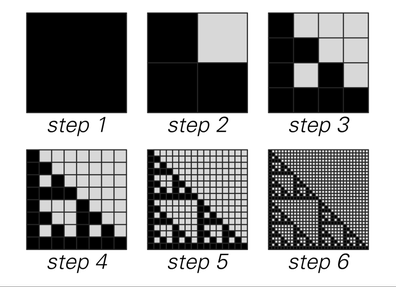Beyond uniformity and repetition, the one further type of simple behavior that we have often encountered in this book is nesting. And as with uniformity and repetition, there are several quite different ways that nesting seems to arise.
Nesting can be defined by thinking in terms of splitting into smaller and smaller elements according to some fixed rule. And as the first set of pictures below illustrates, nested patterns are generated very directly in substitution systems by each element successively splitting explicitly into blocks of smaller and smaller elements.
An essentially equivalent process involves every element branching into smaller and smaller elements and eventually forming a tree-like structure, as in the second set of pictures below.
So what makes a system in nature operate in this way? Part of it is that the same basic rules must apply regardless of physical scale. But on its own this would be quite consistent with various kinds of uniform or spiral growth, and does not imply that there will be what we usually think of as nesting. And indeed to get nesting seems to require that there also be some type of discrete splitting or branching process in which several distinct elements arise from an individual element.
 |  |
Nesting in one- and two-dimensional neighbor-independent substitution systems in which each element breaks into a block of smaller elements at each step.
Nested patterns generated by simple branching processes. (Compare page 406.)



